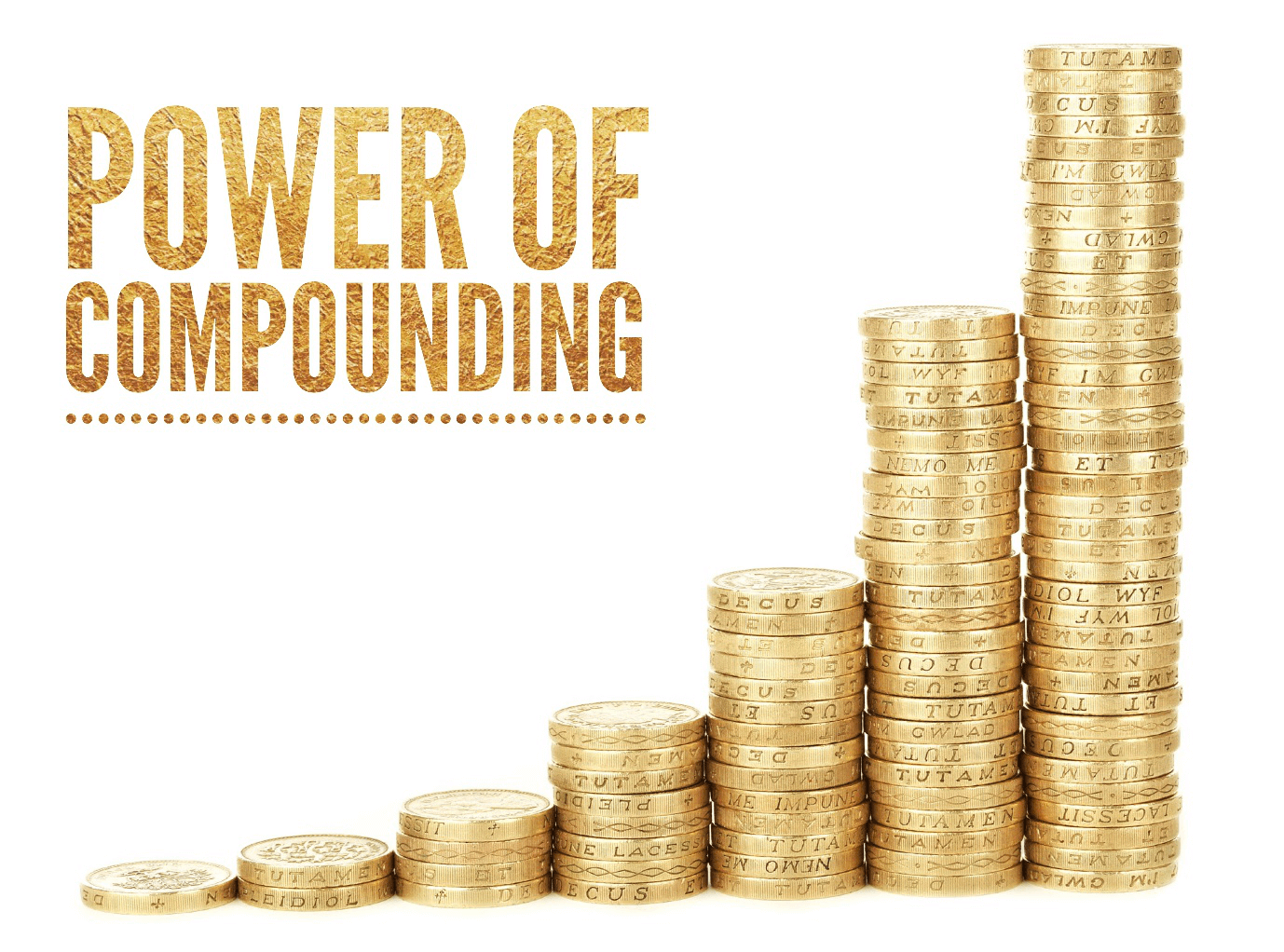Power of compounding in 2022, Know everything.

The interest earned on interest is referred to as compound interest. Compound interest allows your investments to grow significantly over time. As a result, if you have a longer investment horizon of five years, even a lesser beginning investment amount can result in higher wealth accumulation.
How does compound interest work, and what is it?
Compounding’s most crucial feature is paying interest on previously earned interest and the primary capital. Compounding is about creating a broad foundation that keeps adding to your prior earnings. If you spend Rs 1 lakh and compound it at 10% each year for the next 15 years, you will have a base of Rs 4,17,725. This is how compounding creates a never-ending cycle of earnings. Keep in mind as an investor that the most critical aspect of compounding is that the investment’s earnings should be reinvested. It is not permissible to withdraw one’s returns at any time. This profit withdrawal will prevent the investment’s base from growing to a more significant amount.
Advantages of Compounding Power
/compound-interest-d0fbc3665a274591bc2cb29e769b3015.gif)
Increased wealth accumulation
This is by far the most significant advantage of compounding power. Because the returns follow a geometric development, it aids in increased wealth growth. This substantially impacts the final corpus at the end of the investing period.
Shortage of bridges in the corpus
You can bridge any deficiency in the goal corpus with mutual fund compounding. You will almost always achieve or get close to obtaining the required corpus.
Allows you to keep up with inflation.
Compounding power in mutual funds allows you to stay up with inflation. It’s important to remember that inflation erodes the value of money over time. When compounding is used, however, you end up with a corpus that equals the inflation rate at the time.
Compounding in Mutual Funds: What Does It Mean?
Mutual funds are designed to take advantage of compounding’s benefits. When the value of fund units rises, investors benefit. If you invest with a long-term view, the power of compounding will be fully realised, allowing you to expand your money. This is especially true in mutual funds, where capital gains are reinvested to generate greater profits.
If you put Rs 1,000 every month in a mutual fund plan for the following ten years at an annual rate of 8%, your initial investment of Rs 1,20,000 will yield a profit of Rs 1,82,946. If you decide to invest it for another ten years, the money you’ve already invested will grow even quicker, bringing you Rs 3,94,967. Compounding has the unique feature of your previous investment and the return on investment and the new investment each month, all contributing to more significant benefits.
|
Year |
Opening balance (₹) |
Investment (₹) |
10% Interest (₹) |
Closing balance (₹) |
|
1 |
– |
1,00,000 |
10,000 |
1,10,000 |
|
2 |
1,10,000 |
1,10,000 |
22,000 |
2,42,000 |
|
3 |
2,42,000 |
1,21,000 |
36,300 |
3,99,300 |
|
4 |
3,99,300 |
1,33,100 |
53,240 |
5,85,640 |
|
5 |
5,85,640 |
1,46,410 |
73,205 |
8,05,255 |
Compound Interest on Investments: How Does It Work?
![Compound Interest Calculator [Formula & How to Calculate] - Mint](https://blog.mint.com/wp-content/uploads/2021/02/pasted-image-0-2-1.png?w=1600)
Consider the following scenario to see how compounding works: Ravi made a one-time investment of Rs 1,00,000 this year. Every year, he will receive a 12 per cent return on his investment. Let’s see how much interest Ravi makes over ten years if he takes his interest out each year versus allowing the compounding principle to work.
|
Scenario 1: Ravi keeps his earned interest aside |
Scenario 2: Ravi reinvests his interest and lets compounding work |
|
Year |
Principal amount |
Interest earned (@12%p.a.) |
Year |
Principal amount |
Interest earned (@12%p.a.) |
|
1 |
1,00,000 |
12,000 |
1 |
1,00,000 |
12,000 |
|
2 |
1,00,000 |
12,000 |
2 |
1,12,000 |
13,440 |
|
3 |
1,00,000 |
12,000 |
3 |
1,25,440 |
15,052.8 |
|
4 |
1,00,000 |
12,000 |
4 |
1,40,492.8 |
16,859.1 |
|
5 |
1,00,000 |
12,000 |
5 |
1,57,351.9 |
18,882.2 |
|
6 |
1,00,000 |
12,000 |
6 |
1,76,234.1 |
21,148.1 |
|
7 |
1,00,000 |
12,000 |
7 |
1,97,382.1 |
23,685.9 |
|
8 |
1,00,000 |
12,000 |
8 |
2,21,462.7 |
26,528.2 |
|
9 |
1,00,000 |
12,000 |
9 |
2,48,038.2 |
29,711.6 |
|
10 |
1,00,000 |
12,000 |
10 |
2,77,802.7 |
33,276.9 |
|
Total interest earned Rs 1,20,000 |
Total interest earned Rs 2,10,584.8 |
|
Total value of investment Rs 2,20,000 after 10 years |
Total value of investment Rs 3,10,584.8 after 10 years |
Ravi earns roughly twice as much interest on his one-time investment by just reinvesting the money gained on his principal amount instead of taking his interest out each year. This demonstrates the value of compounding.
Compounding works so that the more you invest when you’re young, the more your money will work for you over time and the sooner you’ll reach financial independence. As a result, if you want to invest correctly, you should take advantage of compounding and start saving and investing early.
Compounding in a Long-Term Investment Has Its Advantages

We’ll look at two situations to see how the power of compounding works in a long-term investment horizon: one-time investment and systematic investment over 30 years.
At the age of 30, Mr. A, an IT engineer, invested Rs.5000 at 12 per cent. He planned to retire by the age of 60 and was putting money aside to do so. Examine how his investment will fare in both simple and compound interest scenarios.
Under Simple Interest (12%)- ₹5,600
Under Compound Interest (12%)– ₹1,49,799.6
If a one-time investment can yield this, imagine the wonders that may be achieved if a small amount is placed away regularly every month or even every year. Let’s look at how a yearly investment of $5,000 will increase over 30 years, assuming a 12-per cent annual rate of return. To calculate the final value of an investment for this calculation, we’ll need to use a compound interest calculator or, because using a formula is too time-consuming, a formula.
We arrive at a final number of 13.46 lakh after using the calculator to calculate the above figure. Over 30 years, a total investment of 1.55 lakh grows to 13.46 lakh. So now it’s evident what compounding’s power can accomplish for our money. Money will begin to earn for itself if we start investing early.
Investing Rules of Thumb

Begin Early:
The secret to being wealthy is to begin investing as soon as possible. The day you receive your first paycheck is a good moment to start your financial adventure. Start investing today if you haven’t already. You may find it challenging to reach your destination if you put off saving.
Be Consistent:
Your portfolio will be healthier if you invest regularly. Wealth is best created via disciplined and focused contributions. Establish priorities. Many people have told me that I won’t be able to meet my demands with this small income, so how can I consider investing? I have one recommendation for them: imagine that you are being paid 10% less.
This means that if you earn Rs. Ten thousand per month, consider your payor income to be Rs. 90,000. If you invest this Rs.1000, you will thank me later in life.
Patience is the key to success:
This is the most critical aspect of accumulating wealth. When you’re in a hurry, don’t make hasty investment decisions. The power of compounding can only be felt and appreciated when investments are allowed to develop at their own pace. Even if it appears that your assets aren’t growing, you might be surprised at what compounding can do for your portfolio after years of careful and disciplined investing.
Compounding’s power is enabled by following a few simple guidelines.
Keep an eye on your spending.
Whether you invest Rs. 100 or Rs. 10,000, the compounding principle is the same. However, if you invest a large sum of money, the amount of interest you get can skyrocket.
The most effective approach to compounding is to increase your investments. If you have a limited income, you can improve your savings by reducing your outgoings. Making a budget and identifying areas where you can cut spending each month is one approach to achieving it. Spending sensibly and intelligently can help you save more money and invest more. This will give you a better chance of receiving better results.
Begin early.
Nothing beats getting a head start on your investments. Ideally, you should begin investing as soon as you start earning money. If you’ve already passed that point, the next best thing is to start investing right now. Start investing in a mutual fund that corresponds with your financial goals. With the help of compounding, you may build a firm foundation for your finances to grow and flourish in the future if you start investing early. You can use an internet calculator if you don’t know how to calculate the return on investment. There are a plethora of calculators online that will tell you precisely how much you need to start investing today to achieve your long-term objectives.
Maintain a strict routine.
It is vital to have investment discipline to build a healthy corpus and reach your financial goals on time. Regular investing at the outset of your investment journey can help you maintain discipline. It’s a good idea to keep up with your SIP payments. When you invest every month, you grow your funds and build investment discipline. This is a must-have habit if you want to be financially successful.
Patience is a virtue.
The majority of investors are looking for immediate profits. However, in their haste to generate rapid cash, they may make blunders that result in significant losses. Compounding’s power grows stronger over time, as we’ve seen. As a result, taking a long-term strategy for investing can be beneficial.
It is necessary to invest patiently to gain healthy profits over time.
You don’t have to be a financial wizard to get the benefits of compounding. This is an idea that any investor may use and put to good use. So start investing now for a bright future.
Compounding Power in SIP Investment Plans

A systematic investment plan (SIP) is a disciplined and straightforward way to grow wealth over time by investing in mutual funds. Instead of a lump-sum payment, SIP investment is made by making tiny recurring instalments. Dividends and capital gains are two types of earnings in mutual funds. You can benefit from compounding if you opt to reinvest your gains in the same plan rather than withdrawing them.
SIP’s Advantages:
SIPs make it easier to grow wealth because they require small, focused investments. You get to invest at both the high and low points in the market by making these investments over a more extended period, averaging over time and reducing the need to time the market.
Mutual funds provide diversity and the benefits of exponential growth in your investments through compounding by mixing a variety of different assets, such as stocks and bonds.
Using an example, explain how compounding works on SIP.
Let’s look at an example to demonstrate compounding. Assume you begin with an Rs. 5,000 monthly SIP invested at a rate of 12 per cent. You’ll have earned Rs. 4,047 by the end of the year. This amount will be added to your initial principal of Rs. 60,000, giving you a new principal of Rs. 64,047. This process will continue, resulting in a future worth of Rs. 4.1 lakhs after five years, Rs. 11.6 lakhs after ten years, and about Rs. Fifty lakhs after 20 years.
By using a SIP calculator, an online tool that helps you calculate the wealth increase and predicted returns on your monthly SIP investments, you can experience the magic of compounding for yourself.
SIP plans are a convenient and straightforward way to reach financial objectives. Starting early and staying persistent are the keys to getting the rewards of compounding.
Compounding Power: Frequently Asked Questions

Q.1: How effective is compounding?
Ans: A money multiplier approach utilized in Mutual Funds is called the power of compounding. The income earned on the principal is reinvested in this strategy, resulting in interest on interest or profit on profits. This technique permits the interest gained to accrue, increasing the investment’s value.
Q.2: How do you use compounding to your advantage?
One of the most significant benefits of compounding is the ability to appreciate the value of your investments. A chain reaction or multiplication of investment occurs as it reinvests your interest or profit generated on principal investment, helping you earn on the interest income until you retain your funds invested.
Q.4: Should interest be compounded daily or monthly?
Ans: Monthly compounding of interest implies that your interest on investments is computed and added to your account at the end of each month. On the other hand, Daily compounding calculates and adds interest to the statement at the end of each day. Compounding’s core concept states that the shorter the compounding duration, you will receive more interest. As a result, daily compounding is preferable to monthly compounding.
Q.5: What are the mutual fund’s 15*15*15 rules?
Ans: The Mutual Funds 15*15*The 15 rule is a concept that involves investing Rs.15,000 every month to accumulate Rs.1 crore. Compound interest is the essential instrument in this calculation. Let’s break it down a little more-
- For example, Mr A intends to invest Rs.15000 per month in an equity fund through a systematic investment plan (SIP) for 15 years, yielding a 15% return.
- Total investment: Rs.15000 divided by 180 months is Rs.27 lakhs.
- 73,00,000 rupees profit (interest income)
- The total amount of money accumulated is Rs.10,000,000.00.
- His wealth would expand tenfold if he extended his investment period by another 15 years.
- So, In 30 years, your investment will be worth Rs.15000*360months=Rs.54 lakhs.
- The total amount of money accumulated is Rs.10.38 crores.
- The profit is Rs.9.84 crores.
Q.6: What is compound interest, and how does it work in investments?
When an individual puts their money in mutual funds for a more extended period, the power of compounding is maximized. When the value of fund units rises, investors benefit. It is carried out in mutual funds when capital gains are reinvested to generate new profits. Here’s an example of compounding’s power in mutual funds: Mr A has decided to invest a lump sum of Rs.1,00,000 per year for the next ten years at 12%.




